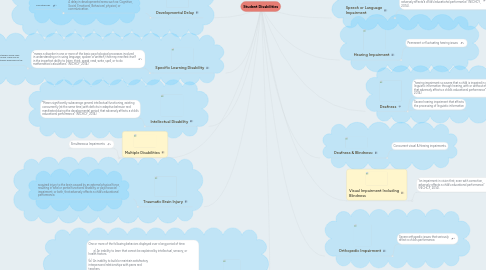Student Disabilities
por Lorrie Robayo


1. Autism
1.1. Developmental disability that affects verbal and non-verbal communication.
1.1.1. case study link:
1.1.1.1. Classroom Strategies: Determine what motivates the student and use this to plan for lessons.
2. Developmental Delay
2.1. A delay in developmental areas such as: Cognitive, Social, Emotional, Behavioral, physical, or communication.
2.1.1. Case study links
3. Emotional Disturbance
3.1. One or more of the following behaviors displayed over a long period of time: a) An inability to learn that cannot be explained by intellectual, sensory, or health factors. (b) An inability to build or maintain satisfactory interpersonal relationships with peers and teachers. (c) Inappropriate types of behavior or feelings under normal circumstances. (d) A general pervasive mood of unhappiness or depression. (e) A tendency to develop physical symptoms or fears associated with personal or school problems. (NICHCY, 2014)
3.1.1. Case study link:
4. Intellectual Disability
4.1. "Means significantly subaverage general intellectual functioning, existing concurrently [at the same time] with deficits in adaptive behavior and manifested during the developmental period, that adversely affects a child’s educational performance" (NICHCY, 2014).
5. Multiple Disabilities
5.1. Simultaneous Impairments
6. Specific Learning Disability
6.1. "means a disorder in one or more of the basic psychological processes involved in understanding or in using language, spoken or written, that may manifest itself in the imperfect ability to listen, think, speak, read, write, spell, or to do mathematical calculations" (NICHCY, 2014).
6.1.1. Classroom Strategies: Depending on the disability the teacher should make observations to see what can be implemented for extra help. There may be needs for pull out sessions for language or cognitive therapy depending on the case.
7. Traumatic Brain Injury
7.1. acquired injury to the brain caused by an external physical force, resulting in total or partial functional disability or psychosocial impairment, or both, that adversely affects a child’s educational performance.
8. Deafness & Blindness:
8.1. Concurrent visual & Hearing impairments.
9. Deafness
9.1. "hearing impairment so severe that a child is impaired in processing linguistic information through hearing, with or without amplification, that adversely affects a child’s educational performance" (NICHCY, 2014).
9.2. Severe hearing impairment that affects the processing of linguistic information
10. Hearing Impairment
10.1. Permanent or fluctuating hearing issues
11. Orthopedic Impairment
11.1. Severe orthopedic issues that seriously affect a child's performance.
12. Other Health Impairment
12.1. "having limited strength, vitality, or alertness, including a heightened alertness to environmental stimuli, that results in limited alertness with respect to the educational environment"(NICHCY, 2014).
13. Speech or Language Impairment
13.1. "a communication disorder such as stuttering, impaired articulation, a language impairment, or a voice impairment that adversely affects a child’s educational performance" (NICHCY, 2014).
13.1.1. Classroom Strategies: Extra help such as pull out sessions for language therapy.
